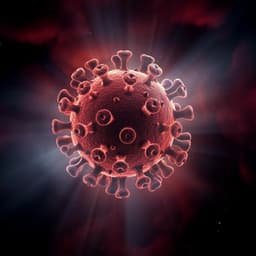
Medicine and Health
Psychiatric adverse events following COVID-19 vaccination: a population-based cohort study in Seoul, South Korea
H. J. Kim, M. Kim, et al.
This groundbreaking study conducted by Hong Jin Kim, Min-Ho Kim, Myeong Geun Choi, and Eun Mi Chun reveals a concerning relationship between COVID-19 vaccination and psychiatric adverse events in South Korea. The research highlights increased risks of various mental health disorders post-vaccination, emphasizing the need for caution in vulnerable populations.
~3 min • Beginner • English
Introduction
The COVID-19 pandemic has adversely affected mental health due to infection, lockdowns, social distancing, and uncertainty. While vaccines (mRNA-based and viral vector) reduced severity and mortality, concerns remain about post-COVID-19 sequelae and vaccine-related adverse events (AEs), including psychiatric outcomes. Prior literature on post-vaccination psychiatric AEs is sparse and largely case reports/series. This study investigates whether COVID-19 vaccination is associated with psychiatric AEs (schizophrenia, depression, bipolar disorder, anxiety/dissociative/stress-related/somatoform disorders, sleep disorders, eating disorders, sexual disorders) using a large, population-based cohort in Seoul, South Korea.
Literature Review
Methodology
Design and data source: Population-based retrospective cohort study using Korean National Health Insurance Service (KNHIS) claims data. A random 50% sample of individuals residing in Seoul on January 1, 2021 was drawn; diagnostic records up to December 31, 2021 were available. The study followed STROBE guidelines and was IRB-approved with informed consent waived due to de-identified data.
Cohort assembly: Initial cohort n=4,348,412 (50% of Seoul population). Exclusions: age <20 years (n=144,525). Individuals were categorized by vaccination status. Vaccinated were those who received two doses by October 1, 2021; those without a second dose by that date were excluded (n=1,684,625). Among unvaccinated (n=364,873), deaths on October 1, 2021 were excluded (n=13,890). To establish incident outcomes, individuals with any primary or secondary diagnosis of target psychiatric AEs within the year prior to the index date were excluded. Final analytic sample: vaccinated n=1,718,999; non-vaccinated n=308,354.
Exposures: COVID-19 vaccination status (two doses vs none as of October 1, 2021). Vaccine products: AZD1222 (ChAdOx1-S), BNT162b2 (Comirnaty), mRNA-1273 (Spikevax), JNJ-78436735 (Janssen). Vaccine type categories: only mRNA, only cDNA (viral vector), heterologous.
Outcomes: Incident psychiatric AEs identified by ICD-10 codes after the index date: schizophrenia; mood disorders (depression, bipolar disorder); anxiety, dissociative, stress-related, and somatoform disorders (including anxiety disorders, OCD, reactions to severe stress and adjustment disorders, conversion and somatoform disorders, other neurotic disorders); sleep disorders; eating disorders; sexual disorders. Outcomes assessed at 1 week, 2 weeks, 1 month, and 3 months.
Covariates: Age, sex, income (proxied by National Health Insurance premium; categorized into low, middle, high), Charlson Comorbidity Index (CCI), comorbidities (diabetes mellitus, hypertension, hyperlipidemia, COPD), prior COVID-19 infection. Comorbidities and prior infection defined as ≥2 primary/secondary diagnoses within one year pre-index.
Statistical analysis: Baseline characteristics compared with t-tests (continuous) and chi-square tests (categorical). Cumulative incidence per 10,000 calculated at each timepoint. Associations assessed using multivariable logistic regression for odds ratios (ORs) with 95% CIs and Cox proportional hazards models for hazard ratios (HRs) with 95% CIs. Two-sided p<0.05 considered significant. Subgroup analyses by sex, age, vaccine dose count, vaccine type, income level, DM, HTN, hyperlipidemia, COPD, and CCI.
Key Findings
- Sample: 2,027,353 adults; vaccinated 1,718,999 (84.79%); non-vaccinated 308,354 (15.21%). Vaccinated were older (mean 54.67 vs 44.18 years) and had more comorbidities.
- Cumulative incidence per 10,000 at 3 months (vaccinated vs non-vaccinated):
• Schizophrenia: 0.51 (95% CI 0.40–0.62) vs 1.98 (1.48–2.47), p<0.001 (lower with vaccination)
• Depression: 18.30 (17.66–18.93) vs 14.24 (12.91–15.57), p<0.001 (higher with vaccination)
• Bipolar disorder: 0.79 (0.66–0.92) vs 1.39 (0.98–1.81), p=0.002 (lower with vaccination)
• Anxiety, dissociative, stress-related, somatoform disorders: 28.41 (27.62–29.21) vs 20.27 (18.68–21.86), p<0.001 (higher with vaccination)
• Sleep disorders: 28.85 (28.05–29.96) vs 12.19 (10.96–13.43), p<0.001 (higher with vaccination)
• Eating disorders: 0.30 (0.22–0.38) vs 0.32 (0.12–0.53), p=0.724 (no difference)
• Sexual disorders: 0.27 (0.19–0.34) vs 0.03 (0.00–0.10), p=0.007 (higher with vaccination)
- Cox HRs for vaccination effect:
• Schizophrenia: HR 0.231 (95% CI 0.164–0.326) — decreased risk
• Depression: HR 1.683 (1.520–1.863) — increased risk
• Bipolar disorder: HR 0.672 (0.470–0.962) — decreased risk
• Anxiety/dissociative/stress-related/somatoform: HR 1.439 (1.322–1.568) — increased risk
• Eating disorders: HR 0.796 (0.395–1.604) — not significant
• Sleep disorders: HR 1.934 (1.738–2.152) — increased risk
• Sexual disorders: HR 6.556 (0.890–48.296) — not significant
- By vaccine type (vs non-vaccinated):
• Schizophrenia incidence lowest with heterologous vaccination (0.42 per 10,000; 95% CI 0.05–0.79; p<0.001).
• Bipolar disorder incidence lowest with only cDNA vaccine (0.39 per 10,000; 95% CI 0.23–0.55; p<0.001).
• Depression incidence highest with heterologous vaccination (23.31 per 10,000; 95% CI 20.56–26.05; p<0.001); only cDNA vaccination showed lower depression incidence than non-vaccinated (12.26 vs 14.24; p=0.014).
• Anxiety/dissociative/stress-related/somatoform highest with heterologous (31.75), then mRNA-only (29.13), then cDNA-only (26.53) per 10,000 (all p<0.001).
• Sleep disorders high with cDNA-only (34.78) and heterologous (32.09), followed by mRNA-only (24.98) per 10,000 (p<0.001).
- Subgroup highlights:
• Age: Higher age slightly increased schizophrenia (HR 1.027 per year) and sleep disorders (HR 1.014), and slightly decreased depression (HR 0.969), bipolar (HR 0.982), and anxiety-related group (HR 0.988).
• Income: High insurance level associated with lower schizophrenia risk (HR 0.593, p=0.007) and lower depression risk (high: HR 0.904, p=0.014; middle: HR 0.824, p<0.001) vs low.
• Comorbidity: CCI ≥2 increased risks of depression (HR 1.393), anxiety-related group (HR 1.440), and sleep disorders (HR 1.315) vs CCI 0.
• Sex: Women were more susceptible to most psychiatric AEs (except sexual disorders).
Discussion
This large, population-based cohort indicates that COVID-19 vaccination is differentially associated with psychiatric outcomes: reduced risk and incidence of psychotic disorders (schizophrenia, bipolar disorder) but increased risk and incidence of neurosis-related conditions (depression, anxiety/dissociative/stress-related/somatoform disorders) and sleep disorders. These findings complement limited prior case reports and add robust epidemiologic evidence on post-vaccination psychiatric AEs.
Potential mechanisms discussed include vaccine-induced immune activation and neuroinflammation (e.g., proinflammatory cytokines, responses to lipid nanoparticles and spike protein), which may contribute to depression and anxiety-related conditions. Heterologous vaccination, which augments B-cell and CD4+ T-cell responses, was associated with higher risks for neurosis-related outcomes. Conversely, reduced psychosis risk may relate to immunologic or metabolic pathways; exploratory gene set enrichment suggested bile acid metabolism pathways linked to schizophrenia, potentially modulating ACE2-spike interactions. Bipolar disorder risk reduction appeared driven primarily by cDNA (viral vector) vaccines, hinting at vaccine-type-specific effects. While mechanistic explanations remain speculative, the data suggest that vaccination may differentially impact neuropsychiatric pathways.
Clinically, the results imply heightened vigilance for depressive, anxiety-related, and sleep disturbances after vaccination, particularly with heterologous or cDNA regimens and among individuals with higher comorbidity burdens, while providing reassurance regarding psychotic disorders. The findings contribute to nuanced risk-benefit discussions and mental health monitoring strategies in vaccination programs.
Conclusion
COVID-19 vaccination was associated with increased risks of depression, anxiety/dissociative/stress-related/somatoform disorders, and sleep disorders, and decreased risks of schizophrenia and bipolar disorder in a large Seoul-based cohort. Vaccine-type analysis suggested heterologous regimens had the highest risks for neurosis-related disorders, while psychosis-related outcomes were reduced across types (especially bipolar disorder with cDNA vaccines). These results underscore the complex, differential psychiatric effects of vaccination and support close monitoring of vulnerable populations when administering additional doses. Future research should include longer-term follow-up, adolescent populations, mechanistic studies to clarify neuroimmune pathways, and multi-national cohorts to assess generalizability.
Limitations
- Outcome misclassification: Reliance on claims-based ICD-10 codes may lead to diagnostic misclassification.
- Baseline imbalance: Differences in demographics and comorbidities between vaccinated and non-vaccinated groups; no propensity score matching was applied.
- Age scope: Individuals under 20 years were excluded; adolescent vaccination began in South Korea in October 2021, limiting inclusion of youth outcomes.
- Follow-up duration: Psychiatric AEs assessed only up to 3 months post-index; long-term effects not captured.
- Generalizability: Findings from Seoul may not generalize globally due to potential ethnic/genetic and health system differences.
Related Publications
Explore these studies to deepen your understanding of the subject.







